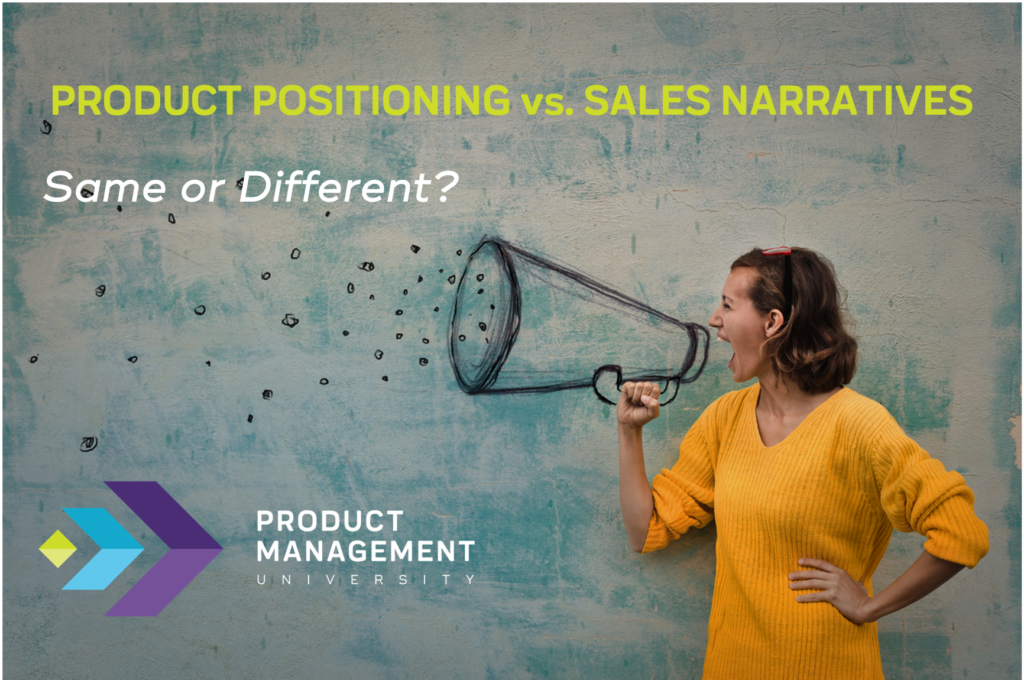Should Product Positioning and Sales Narratives be Different?

Does your product positioning need to be different than your sales narratives?
The short and simple answer is no, but it’s highly dependent on how your product positioning is constructed.
As a former product marketing manager, I know this all too well and was guilty in the first degree!
We tend to overthink our messaging, try to say too much, try too hard to be eloquent with our words and if there aren’t a lot of superlatives and buzzwords, we feel like we’ve failed. The end result is we’re speaking a language that’s difficult for anyone to decipher, or it’s so generic and fluffy, it doesn’t say anything.
Salespeople on the other hand speak in simple layperson terms. No salesperson would ever use our product positioning dialogues when talking with prospects and customers.
So why not create your positioning in conversational layperson speak and take care of both objectives in one fell swoop? It would save a ton of work for product marketing, plus, your product positioning that opens doors for salespeople would be the same as the conversations they’re having with buyers.
It’s Simple
It’s so simple and it works like a charm!
Here’s what I can tell you now that I train product marketing managers and sales/pre-salespeople. We use the same exact framework to create the narrative for both. It’s completely conversational on both fronts. Sales presentations and demos are nothing more than verbal positioning!
There’s no reason for your website, marketing materials, campaigns and everything else that involves product positioning shouldn’t be conversational too.
The more conversational your positioning, the more engaging it is because your target customers feel like you’re actually speaking to them even when they’re reading something about your products.
Furthermore, think about conversational product positioning and how it makes your value story easier to internalize and repeat, for salespeople and buyers alike. This part is really important because there are all too many occasions where you’re dependent on others to carry your message to the appropriate influencers and buyers. It has to be easy for them to tell your value story the same way you tell it.
In the ideal world, your product messaging that’s intended to attract and engage buyers should be the same as the conversations they’re having with salespeople in the throes of the sales process. The lack of consistency is one of the biggest thing that confuses buyers and can put your sales team at a disadvantage.
A Contrasting Product Positioning Example
Here’s a contrasting example that illustrates the simplicity of making your product positioning the same as your sales narratives.
The following is a product positioning statement as written by product marketing.
XXX offers virtual evidence-based treatment for opioid and alcohol addiction through a mobile application for those who experience significant barriers to in-person care.
This is one of the simpler positioning statements I’ve seen yet it’s still not conversational. Most are too verbose and overloaded with buzzwords.
Here’s the conversational version you’d respond with if someone asked what your product does.
“A mobile app that treats people with opioid and alcohol addictions when they can’t get in-person care.”
There’s no reason the conversational version of your product positioning shouldn’t be the product marketing version or vice-versa. The real acid test comes when you explain your product positioning to a third grader or your grandparents. If they understand it, you’re in great shape. That means it’s a no-brainer for your target customers to understand too. Easier to understand, easier to buy!
If you’re creating two versions of your positioning, you’re working way harder than you need to!
If you want to learn how to create the simple conversational version of your product positioning that supports both marketing and sales initiatives, Click here if you want to and experience the easiest way to learn product management, product marketing, pre-sales demos and customer success with our unique hands-on learning format.
Be sure to check out our Product Management Framework that simplifies everything by making customer outcomes the starting point for building, marketing, selling and delivering strategic value.
You might also like:
- Creating a Sales Playbook: 5 Must-Haves
- Top 5 Reasons Your Positioning Falls on Deaf Ears
- How to Create a B2B Sales Demo Script
by John Mansour on July 19, 2023.